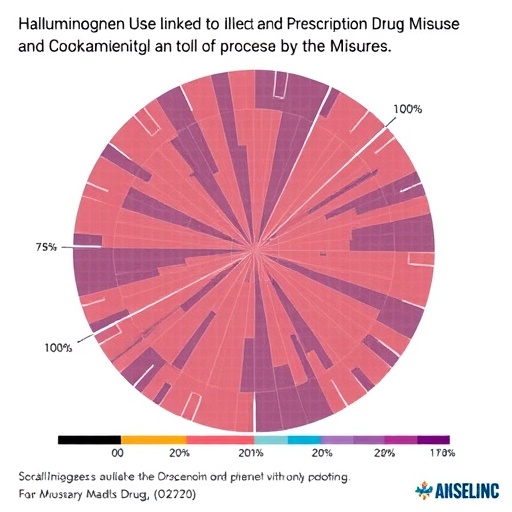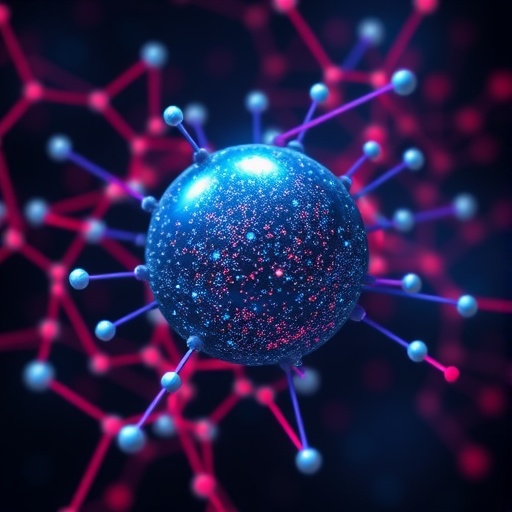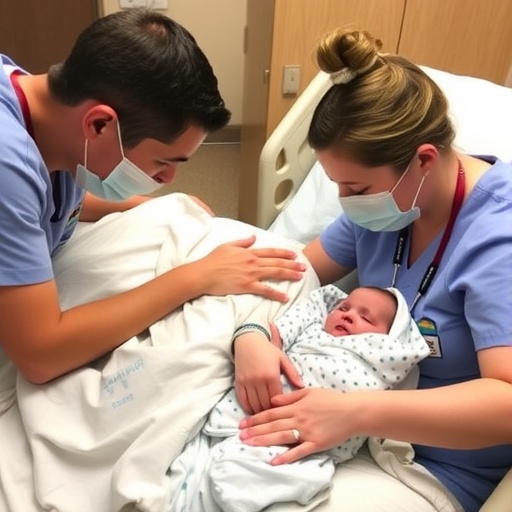In recent years, the landscape of substance use in the United States has undergone significant shifts, with hallucinogens emerging from the shadows of countercultural stigmas to more prominent and complex roles in public health discussions. A groundbreaking national survey, recently published in the International Journal of Mental Health and Addiction, offers a comprehensive examination of hallucinogen use among American adults, while also scrutinizing the intricate relationships between these substances, illicit drug use, and prescription drug misuse. This extensive dataset sheds new light on evolving patterns, suggesting far-reaching implications for policymakers, healthcare professionals, and researchers alike.
The study meticulously captures the prevalence and demographics of hallucinogen use, employing rigorous sampling and analytical methodologies that ensure robust, generalizable conclusions. Hallucinogens—psychedelic substances such as LSD, psilocybin mushrooms, and MDMA—have historically been classified predominantly as illicit drugs. However, emerging scientific inquiries and therapeutic trials have nuanced this perspective, highlighting potential medical applications alongside recreational and non-medical consumption. The researchers’ approach harmonizes epidemiological breadth with clinical depth, unraveling a complex behavioral mosaic wherein hallucinogen users frequently intersect with other substance use categories.
Crucially, the survey elucidates the extent to which hallucinogen consumption correlates with other forms of illicit drug use, probing distinctions in user profiles and underlying psychosocial drivers. The data reveals that adults reporting hallucinogen use often concurrently engage in multiple substance use behaviors, encompassing stimulants, opioids, and cannabinoids. These multidimensional usage patterns underline a convergence of risk factors and social determinants, including mental health conditions, socioeconomic status, and environmental stressors, which collectively fuel polysubstance consumption. Understanding these intersections is vital for developing targeted interventions and harm reduction strategies.
.adsslot_ZJREKSk2NB{width:728px !important;height:90px !important;}
@media(max-width:1199px){ .adsslot_ZJREKSk2NB{width:468px !important;height:60px !important;}
}
@media(max-width:767px){ .adsslot_ZJREKSk2NB{width:320px !important;height:50px !important;}
}
ADVERTISEMENT
Beyond illicit substances, the study draws attention to prescription drug misuse in hallucinogen users, a relationship that complicates both clinical management and public health response. Prescription drug misuse—particularly involving opioids, benzodiazepines, and stimulants—remains a pressing epidemic in the U.S. The research signals that individuals engaging with hallucinogens are at an elevated risk of misusing prescription medications, necessitating nuanced clinical screening and comprehensive substance use assessments. These findings prompt critical questions about self-medication behaviors, the role of psychedelic experiences in modulating psychological distress, and systemic gaps in addiction treatment.
The survey’s methodological sophistication merits emphasis. Utilizing nationally representative samples derived through probabilistic methods, the study applies advanced statistical modeling, including multivariate regressions and latent class analyses, to dissect complex associations among variables. The longitudinal component permits tracking of trend dynamics over time, enabling the identification of emergent patterns and potential causal pathways. Moreover, the researchers integrate diverse demographic markers—age, gender, ethnicity, education, and geographic region—to map heterogeneity in substance use behaviors with granular precision.
This intricate analytical framework uncovers notable demographic trends. Young adults, particularly those aged 18 to 25, demonstrate the highest rates of hallucinogen use, often accompanied by elevated incidences of concurrent illicit and prescription drug use. Conversely, older adults tend to present more isolated hallucinogen usage patterns, frequently within therapeutic or spiritual contexts. Gender disparities also emerge, with males more likely to report polysubstance involvement. These demographic nuances elucidate critical targets for education campaigns, prevention programming, and tailored clinical approaches.
The survey situates its findings within the broader sociocultural context of increasing public discourse around psychedelics. Media coverage of psychedelic-assisted therapies for depression, PTSD, and addiction has catalyzed shifting perceptions, potentially influencing patterns of recreational and non-medical use. The researchers caution, however, that the glamorization of hallucinogens may obscure risks associated with unsupervised consumption and polysubstance interactions. The complex interplay between cultural normalization and public health risk underscores the necessity for balanced, evidence-based communication strategies.
From a neuropharmacological standpoint, hallucinogens elicit profound alterations in brain function, acting primarily through serotonergic pathways—chiefly the 5-HT2A receptor system. The survey’s findings provoke intriguing questions regarding how these neurochemical effects might mediate or exacerbate tendencies toward other substance use. Biosignaling cascades triggered by hallucinogens could theoretically modulate reward circuits, impulse control, and emotional regulation, potentially influencing patterns of prescription drug misuse. While the national survey does not delve into mechanistic neuroscience, it establishes important epidemiological foundations for future translational research.
An equally important dimension addressed is the psychiatric comorbidity associated with hallucinogen users. Elevated rates of anxiety, depression, and other mood disorders are documented among this population, suggesting complex bidirectional relationships between psychiatric distress and substance use. The data implies that while some individuals may pursue hallucinogens for their anxiolytic or mood-enhancing effects, others might inadvertently exacerbate symptoms through uncontrolled use. This interface between mental health and substance use demands integrated clinical models that accommodate the unique challenges presented by hallucinogens within multifaceted addiction profiles.
The ramifications of these findings extend deeply into public health policy. Current regulatory frameworks often categorize hallucinogens alongside opioids and stimulants without accounting for distinctive risk-benefit profiles. The nuanced understanding gleaned from this study argues for differentiated policy approaches, balancing containment of misuse and harm against facilitation of legitimate therapeutic exploration. Moreover, healthcare systems must escalate capacities for screening and intervention targeted at polysubstance users, particularly those engaging with hallucinogens and prescription medications concurrently.
In exploring social determinants, the authors highlight structural inequities that disproportionately affect marginalized communities, where compounded stress and limited healthcare access elevate risk for polysubstance use and related harms. Geographic disparities further emerge, with urban centers showing higher hallucinogen use relative to rural areas, signaling the influence of cultural milieus and availability factors. These patterns call for place-based interventions and resource allocation tuned to sociogeographical realities to effectively mitigate public health impacts.
The research also touches on prevention and education imperatives amid evolving drug landscapes. Traditional abstinence-based messaging may lack resonance with contemporary users, especially younger adults enrolling hallucinogens within broader lifestyle and wellness paradigms. Harm reduction strategies—such as safe usage guidance, community-based support networks, and destigmatization of seeking help—appear more promising. Additionally, prescription drug monitoring programs must adapt to recognize the interplay between hallucinogen use and prescription misuse to optimize effectiveness.
Importantly, the survey’s timing intersects with the burgeoning field of psychedelic medicine, which simultaneously validates controlled hallucinogen administration and raises concerns about unsupervised consumption. This dual reality provides a unique window to recalibrate public health responses, emphasizing education on safe use, integration of psychedelic therapies into clinical practice with adequate oversight, and ongoing surveillance to detect shifts in community patterns. Scientific rigor and policy innovation must coalesce to navigate this complex terrain prudently.
The broader implications of these findings challenge simplistic narratives that categorize hallucinogens as either benign or purely dangerous. Instead, they affirm a multifaceted understanding, recognizing both the therapeutic potential and the risks when hallucinogens intersect with other drug use. This evolving knowledge base necessitates a recalibration of research priorities, funding, and clinical training, fostering interdisciplinary collaborations that span neuroscience, psychiatry, epidemiology, and social science domains.
By unpacking the nuanced relationships between hallucinogen use, illicit drug involvement, and prescription drug misuse on a national scale, this landmark survey contributes critical data to an urgently needed discourse. It equips stakeholders with evidence to craft informed strategies that balance innovation in mental health treatment, rights-based harm reduction, and proactive prevention. As psychedelic substances continue their complex trajectory through societal, medical, and regulatory frameworks, such foundational research will be indispensable for shaping responsible futures.
In sum, the national survey spearheaded by Lee, Arndt, Joji, and colleagues marks a pivotal advancement in understanding contemporary drug use dynamics in the United States. Their comprehensive analysis not only delineates current patterns of hallucinogen use but also integrates this knowledge within broader substance use and mental health matrices. Harnessing these insights promises to enhance public health responses and catalyze scientific progress in addressing the challenges and opportunities posed by psychedelics amid the evolving drug ecosystem.
Subject of Research: Hallucinogen use and its association with illicit drug use and prescription drug misuse among adults in the USA.
Article Title: Hallucinogen Use and Associated Illicit Drug Use and Prescription Drug Misuse Among Adults in the USA: Results from a National Survey.
Article References:
Lee, YH., Arndt, S., Joji, C. et al. Hallucinogen Use and Associated Illicit Drug Use and Prescription Drug Misuse Among Adults in the USA: Results from a National Survey. Int J Ment Health Addiction (2025). https://doi.org/10.1007/s11469-025-01506-1
Image Credits: AI Generated
Tags: comprehensive survey on hallucinogen consumptiondemographic analysis of hallucinogen usersevolving patterns in drug misusehallucinogen use and prescription drug misuseimplications for policymakers and healthcare professionalsintersection of hallucinogen and illicit drug usemedical applications of hallucinogensnational survey on substance use trendspsychedelic substances in public health discussionspsychedelic therapy and recreational userelationships between hallucinogens and illicit drug usetrends in substance use among American adults





